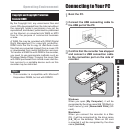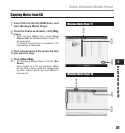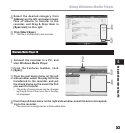
49
Using the Recorder on Your PC
5
Transfer the Voice Files to Your PC
The 5 voice folders of this recorder are appeared
as [DSS_FLDA], [DSS_FLDB], [DSS_FLDC],
[DSS_FLDD] and [DSS_FLDE], and the recorded
voice files are saved in these folders.
1
Connecting the recorder to your PC
Windows
1
Connecting the recorder to your PC
(☞ P.47).
2
Open the Explorer window.
3
Open the [
LS_10
] folder.
• When you open [My Computer], it will
be recognized by the drive name [LS_10]
(Built-in flash memory) and [Removable
Disk] (SD card) (The drive letter will differ
depending on the PC being used).
4
Copy the data.
5
Disconnecting the recorder to your PC
(☞ P.48).
Macintosh
(☞ P.47).
• When you connect the recorder to a Mac
OS, it will be recognized by the drive name
[LS_10] on the desktop. When an SD card
is inserted it will be recognized by the drive
name [Untitled].
2
Double-click on [
LS_10
] icon on the
desktop.
3
Copy the data.
4
Disconnecting the recorder to your PC
(☞ P.48).
Notes
• While transmitting data, [Busy] is appeared,
and the [PEAK] indicator light flashes. NEVER
disconnect the USB while the [PEAK] indica-
tor light is flashing. If you do, the data will be
destroyed.
• In the Windows operational environment 24 bit
WAV format files cannot be played back.
• When a sound board of your PC does not
support to 24 bit, the recorder cannot play the
software supporting to 24 bit correctly.
• In the Mac OS operational environment, WMA
format files cannot be played back.
Built-in flash memory
Drive name Folder name
Windows
Macintosh
DSS_FLDA
LS_10
Folder A
DSS_FLDB
Folder B
DSS_FLDC
Folder C
DSS_FLDD
Folder D
DSS_FLDE
Music
Folder E
Folder name
Folder A
Folder B
Folder C
Folder D
Folder E
SD card
Drive name
Removable
Disk
Untitled
DSS_FLDA
DSS_FLDB
DSS_FLDC
DSS_FLDD
DSS_FLDE
Music
4 Drive name and folder name when a
personal computer is connected:


















